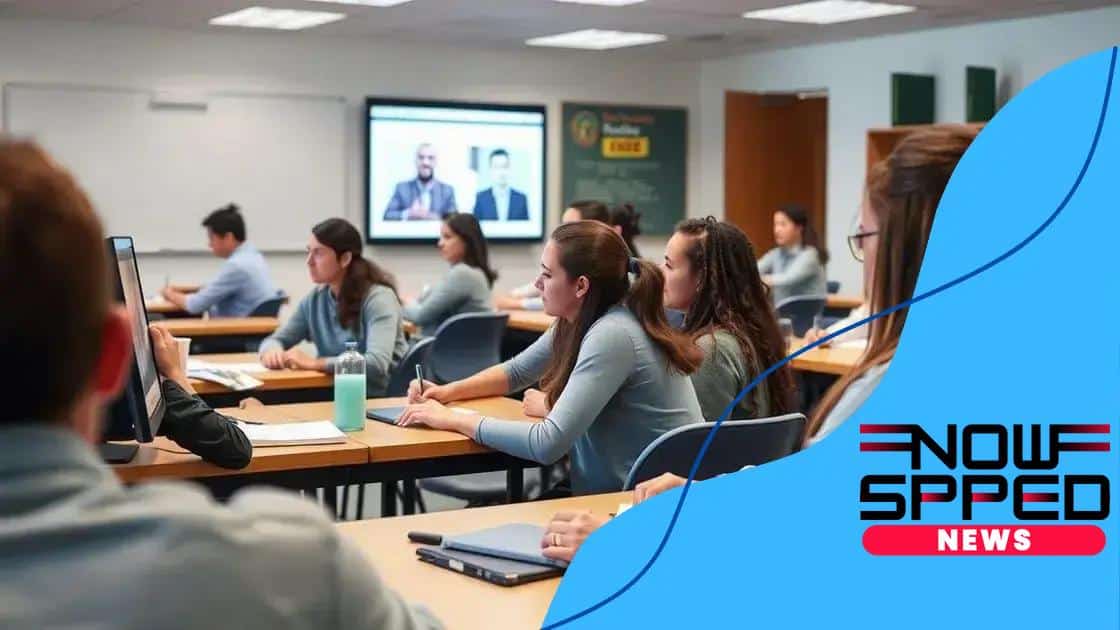Hybrid education systems post-COVID-19: A new era

Hybrid education systems combine online and in-person learning, offering flexibility, personalized education, and diverse engagement strategies to meet the needs of today’s students.
Hybrid education systems post-COVID-19 have changed the landscape of learning, blending technology with traditional classroom experiences. Are you curious about how these systems impact students and teachers alike? Let’s dive in and explore this new approach.
Understanding hybrid education systems
Understanding hybrid education systems is essential in today’s fast-evolving learning environment. These systems combine traditional face-to-face instruction with online learning, creating a flexible approach to education.
One key aspect of hybrid education is its ability to cater to different learning styles. Students can engage in hands-on activities while also utilizing digital resources to enhance their understanding. This blend of learning methods supports various learners effectively.
Benefits of Hybrid Education
There are numerous benefits associated with hybrid education systems:
- Flexibility: Students can choose when and where to learn.
- Personalized Learning: Educators can tailor content to meet individual student needs.
- Enhanced Engagement: Interactive tools keep students motivated.
- Broad Access: More learners can participate, regardless of their location.
The integration of technology plays a vital role in these systems. With digital platforms, students can access a wealth of resources at their fingertips. This accessibility promotes greater autonomy in learning. Additionally, it fosters collaboration among peers through online discussions and group projects.
As we explore hybrid education systems, it’s important to consider the challenges they present. Not all students have equal access to technology. Some may struggle with the online components, leading to disparities in learning outcomes. Therefore, it’s crucial for educators and institutions to address these gaps to create an equitable educational environment.
Key Elements of Effective Hybrid Learning
For hybrid education systems to be successful, several key elements must be established:
- Clear communication between teachers and students.
- Robust technological support to facilitate online learning.
- Engaging and relevant content that resonates with students.
- Regular feedback to ensure students are on track.
By focusing on these factors, educational institutions can enhance the effectiveness of their hybrid models. As we move further into this learning revolution, understanding hybrid education systems will become increasingly vital for educators and students alike.
The benefits of hybrid learning environments
The benefits of hybrid learning environments are numerous and impactful. As education evolves, more schools and colleges are adopting this model. The combination of in-person and online education offers flexibility for both students and teachers.
One major advantage is that students can learn at their own pace. In a hybrid classroom, they can review recorded lectures anytime. This ability to rewind and revisit complex topics enhances understanding. Not to mention, having access to a variety of learning resources increases engagement.
Enhanced Learning Experience
In hybrid environments, the learning experience is often enriched by diverse methodologies:
- Personalization: Educators can tailor lessons for individual student needs.
- Accessibility: Students can join classes from anywhere, as long as they have internet access.
- Collaboration: Technology facilitates teamwork, allowing students to connect with peers easily.
- Resource Variety: A mix of physical and digital materials can cater to various learning styles.
Furthermore, hybrid learning environments help to develop critical skills. Students are exposed to technology, which is essential in today’s job market. They learn to manage their time effectively while balancing both online and offline responsibilities. This exposure prepares them for future careers that demand adaptability and proficiency with digital tools.
Another significant benefit is the potential for increased student satisfaction. Surveys have shown that many learners appreciate the flexibility and choice that hybrid models offer. They can follow their interests while still meeting curriculum requirements. By fostering a positive attitude toward learning, students are more likely to remain engaged in their education.
Cost-Effectiveness
Hybrid learning can also be cost-effective for institutions. Schools can save on physical resources while still providing quality education. Investing in technology and online platforms often leads to long-term savings. Students too can benefit as they may save on commuting and housing costs.
With all these advantages in mind, it is clear why many educational institutions are embracing hybrid learning environments. This innovative approach not only meets the needs of today’s learners but also prepares them for success in a rapidly changing world.
Challenges faced by students and educators

While hybrid education systems offer many benefits, they also present unique challenges for both students and educators. Understanding these hurdles is crucial for making hybrid learning environments successful.
One of the primary challenges is ensuring all students have equal access to necessary technology. Not every student has a reliable internet connection or a device suitable for online learning. This digital divide can lead to gaps in education, particularly for those from low-income backgrounds, as they may struggle to keep up with peers.
Engagement and Motivation
Another significant issue is maintaining student engagement. In a hybrid setup, some students may find it easier to tune out during online sessions. Teachers must find innovative ways to keep students interested and motivated. This often means incorporating interactive activities and using engaging multimedia resources to hold students’ attention.
- Regular feedback can help students stay accountable.
- Incorporating group projects can enhance collaboration.
- Using gamification can make learning more enjoyable.
Additionally, teachers face challenges in adapting their teaching methods for a mixed environment. They must become proficient with digital tools while continuing to support students in a traditional classroom setting. This dual approach can be overwhelming, especially if educators are not given the training or resources they need to be effective.
Classroom management also transforms in a hybrid model. In-person students must be kept engaged, while online students require attention as well. This balancing act can create stress for teachers, potentially impacting their teaching quality.
Social Interaction
Another challenge is the reduced social interaction for students. In traditional classrooms, students bond and learn from one another. In a hybrid setting, some may feel isolated, especially those who primarily engage online. Educators must intentionally create opportunities for social connection among all students, ensuring they feel a sense of belonging.
To address these challenges, schools and educators must be proactive. Ongoing training for teachers is essential, as is providing resources for students to ensure everyone has equal access. By identifying and tackling these issues head-on, we can create a more effective and inclusive hybrid learning environment.
Strategies for effective hybrid education
Implementing effective strategies for hybrid education can make a significant difference in student engagement and overall success. By carefully designing the learning experience, educators can combine the best of both in-person and online teaching.
One crucial strategy is to leverage technology to enhance learning. Using platforms that facilitate communication between students and teachers can improve interaction. Tools like discussion boards, virtual classrooms, and interactive presentations can create a rich learning environment.
Flexible Scheduling
Flexible scheduling is another key element. Allowing students to choose when they participate can accommodate different learning styles and personal commitments. Hybrid models can incorporate both synchronous (real-time) and asynchronous (on-demand) learning options. This flexibility can lead to increased motivation as students feel more in control of their education.
- Encouraging collaboration through group assignments can foster a sense of community.
- Utilizing multimedia resources can appeal to visual and auditory learners.
- Providing clear expectations and guidelines helps students stay focused.
Additionally, it is vital to create opportunities for face-to-face interaction. Regular in-person meetings can strengthen relationships among students and between students and teachers. These connections are essential for building trust and ensuring that students feel supported.
Feedback is another important aspect of effective hybrid education. Teachers should frequently check in with students to gauge their understanding and adjust instruction accordingly. This could mean creating quick surveys or polls after lessons to assess learning outcomes.
Professional Development
Professional development for educators is essential in adapting to hybrid formats. Continuous training on new technologies and teaching strategies helps teachers feel more confident in their abilities. Sharing best practices among colleagues also fosters a collaborative culture where educators can learn from one another.
By implementing these strategies, educational institutions can enhance the effectiveness of hybrid education. The goal is to create a supportive and engaging learning environment that meets the needs of all students.
Future trends in hybrid learning
The landscape of education is constantly changing, especially with the rise of hybrid learning. As we look to the future, several trends are emerging that will shape how students learn.
One significant trend is the increased use of artificial intelligence (AI) in educational tools. AI can personalize learning experiences by adapting content to meet individual student needs. This tailored approach can help students grasp concepts more effectively and at their own pace. Furthermore, AI can assist teachers by automating administrative tasks, allowing them to focus on teaching.
Integration of Virtual and Augmented Reality
Another exciting development is the integration of virtual reality (VR) and augmented reality (AR) into hybrid learning environments. These technologies can create immersive experiences that enhance understanding of complex topics. For example, students can explore historical sites or conduct virtual science experiments from the comfort of their homes.
- Engaged learning: VR and AR can make lessons more interactive.
- Hands-on experience: Students can practice skills in a safe, simulated environment.
- Global learning: These tools can connect students worldwide, enriching their cultural awareness.
Additionally, the demand for flexible learning options will continue to grow. As remote work becomes more common, students may prefer hybrid models that allow them to balance education and personal commitments. Educational institutions will need to adapt their schedules and offerings to meet these changing needs.
Collaboration tools are also becoming increasingly important in hybrid learning. Platforms that facilitate communication and teamwork among students and teachers will enhance the educational experience. These tools allow for real-time feedback and support, fostering a sense of community even in a digital space.
Focus on Social-Emotional Learning
Finally, there will be a greater emphasis on social-emotional learning (SEL) in hybrid education. As educators recognize the importance of mental health, they will work to create supportive environments that address students’ emotional needs. Incorporating SEL into the curriculum helps students develop valuable skills such as empathy, resilience, and emotional regulation.
The future of hybrid learning holds promise, with advancements in technology and teaching methods. By embracing these trends, educators can create more engaging, effective, and inclusive learning experiences for all students.
FAQ – Frequently Asked Questions about Hybrid Education Systems
What are hybrid education systems?
Hybrid education systems combine traditional face-to-face instruction with online learning, offering flexibility and diverse learning methods.
What are the benefits of hybrid learning?
Hybrid learning enhances engagement, personalizes education, and provides flexibility, catering to various learning styles and needs.
What challenges do students face in hybrid education?
Students may face challenges such as unequal access to technology and decreased social interaction, affecting their learning experience.
How can educators adapt to hybrid learning?
Educators can adopt new technologies, engage in professional development, and create inclusive environments that support both in-person and online learners.





